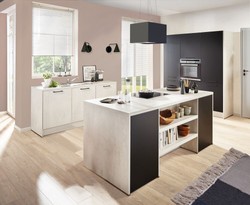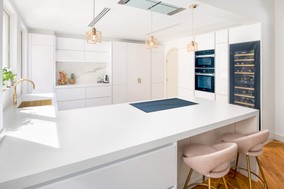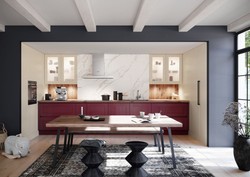A convenient kitchen layout is one that enables effortless movement while cooking or preparing meals with everything easily accessible. There is no point in striving for a visually appealing kitchen if it lacks practicality and physical enjoyment. Functionality and ease of use should be the main priorities to consider in the design and the most effective solutions to ensure your kitchen is practical as well as beautiful is to incorporate kitchen zones by creating areas for the different tasks you expect to use the space for, creating a more ergonomic kitchen.
A common design principle when it comes to kitchen design is called the ‘work triangle’. It refers to the area formed between the sink, refrigerator, and stove. This space is considered the most important part of the kitchen, as it is where most of the food preparation and cooking takes place. The idea behind the work triangle is to create an efficient flow of movement between these three key areas, making it easy for the person using the kitchen to move between them. Senior designer Rohit Patel lists what the kitchen zones are and shares a few tips on how to maximise functionality in these areas.
Fridge
The fridge should be in a location which is easy to start the cooking journey. With enough worktop space around it allows grocery loading to be prompt and gathering ingredients for food preparation to be easier and more convenient.
Cleaning Area
This area is typically located near the sink, as it is designated for cleaning dishes, utensils, and other kitchen items. It should be equipped with a sink, a dishwasher if needed, and storage space for cleaning supplies. Having a minimum of 45 cm worktop space on both sides of the sink is beneficial and provides more room for different activities, increased efficiency, and flexibility.
Preparation Space
This zone provides ample room for cutting, chopping and other food preparation tasks and helps keep the kitchen organised and reduce clutter by providing designated areas for specific chores. This is where the magic happens, so it is important to have all the utilities nearby. The specific items in your preparation zone may vary depending on your personal cooking preferences but having drawers for the pots and pans, pull out baskets for the spices and oils, easy organised dividers for the cooking utensils, an integrated pull-out bin and workstation on both sides of the stove will allow for a comfortable and practical meal preparation.
Additional key zones which are common in today’s modern kitchen:
Beverage Station
If possible, it is recommended to create another zone apart from work zones: the beverage center. This offers a designated and multi-functional area to store and display soft drinks, beer, wine, and everything in between. When placed away from the main preparation area, it is the perfect complement to any room and is an accessible place for friends and family to find their own drinks without interfering with the main workflow of the kitchen.
Seating Area
The seating area creates a clear and separate zone for specific activities which can improve the functionality of the kitchen. It also serves as a visual boundary separating the kitchen from other areas of the home. By doing so, it provides a sense of privacy in the kitchen, making it an ideal place to relax, entertain, and have meals with family and friends. Additionally, it can be a focal point, adding character and interest to the overall design of the space.
When designing your kitchen, it is essential to prioritise both form and function. The main focus should be on ensuring that the design enhances functionality and ease of use. One of the most effective ways to achieve a practical and aesthetically pleasing kitchen is by incorporating well-defined kitchen zones that cater to the specific tasks you anticipate performing. This approach creates designated areas within the kitchen for different functions, resulting in a more ergonomic and efficient space. Visit our Sheikh Zayed Road showroom where our team of expert Kaiser designers will be delighted to assist you every step of the way in the design process.





